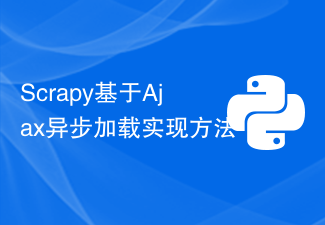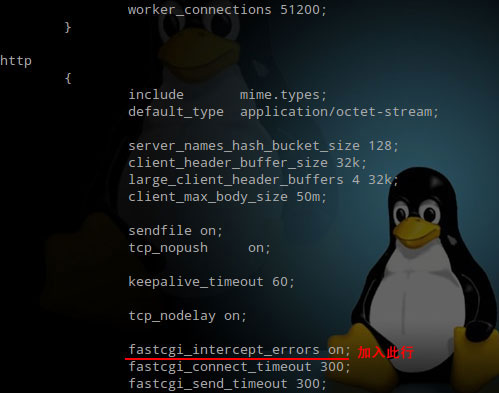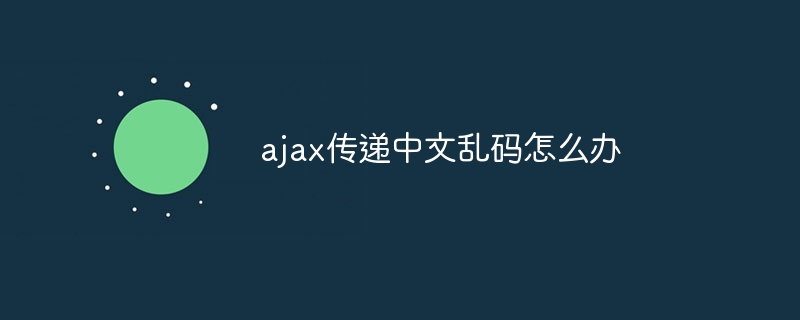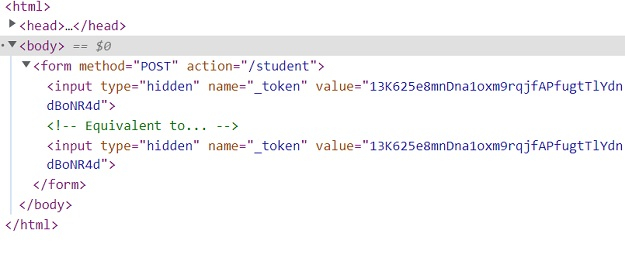 Web Front-end
Web Front-end JS Tutorial
JS Tutorial XMLHttpRequest object properties and the advantages and disadvantages of ajax
XMLHttpRequest object properties and the advantages and disadvantages of ajaxThis time I will bring you the XMLHttpRequest object attributes and the advantages and disadvantages of ajax. What are the precautions for using the XMLHttpRequest object attributes and the advantages and disadvantages of ajax. The following is a practical case, let's take a look.
The XMLHttpRequest object has three important attributes: onreadystatechange state changeeventtrigger, this will be triggered every time the state changesEvent handler
readyState changes from 0 to 40 = Not initialized1 =Loading/server connection established2 =Loaded/Request received3 =Interacting/Request processing4 =Request completedstatusHTTP of the serverStatus code:
1 prefix: message. This type of status code means that the request has been accepted and needs to continue processing. 2 prefix: success. This type of status code means that the request has been successfully received, understood, and accepted by the server. (200:'OK')3 prefix: redirect. This type of status code indicates that the client needs to take further action to complete the request. (304:'Not Modified')4 prefix: Request error. This type of status code represents that an error may have occurred on the client, which is hindering the server's processing. 5, 6 Prefix: Server error. This type of status code represents an error or abnormal state in the process of processing the request by the server.Advantages of AjaxUpdating data without refreshingThe biggest advantage of AJAX is that it can update the entire file without refreshing it. Communicate with the server to maintain data on the premise of the page. This allows web applications to respond to user interactions more quickly and avoids sending unchanged information over the network, reducing user waiting time and bringing a very good user experience.
AJAX uses an asynchronous method to communicate with the server, without interrupting the user's operation, and has a faster response capability. Optimizes the communication between Browser and Server, reducing unnecessary data transmission, time and data traffic on the network.
AJAX can transfer some of the work previously burdened by the server to the client, using the client's idle capabilities to process it, reducing the burden on the server and bandwidth, saving space and bandwidth rental cost.
And reduce the burden on the server, the principle of AJAX is to "get data on demand", which can minimize the burden caused by redundant requests and responses on the server and improve site performance
AJAX is based on standardized and widely supported technology. It does not require downloading browser plug-ins or applets, but requires the customer to allow
JavaScript to be executed on the browser. As Ajax matures, some program libraries that simplify the use of Ajax have also come out. Likewise, another assistive programming technology has emerged to provide alternative functionality for users who do not support JavaScript.
Ajax separates the interface and application in the WEB (it can also be said to separate data and presentation), which is conducive to division of labor and cooperation and reduces WEB applications caused by non-technical personnel's modification of the page. Program errors, improved efficiency, and more suitable for the current
release system.
AJAX kills the history function, which is the destruction of the browser mechanism:
In the case of dynamically updating the page, the user cannot return to the previous page state, because the browser can only remember the static page in the history record . The difference between a page that has been completely read and a page that has been dynamically modified is very subtle;
Users will usually expect that clicking the back button will cancel their previous operation, but in an Ajax application, this will not be possible.
Those who have used Gmail know that the Ajax technology used under Gmail solves this problem. You can go back under Gmail'.
However, it cannot change the Ajax mechanism. It is just a relatively stupid one. But an effective way is to reproduce the changes on the page by creating or using a hidden IFRAME when the user clicks the back button to access the history. A related point is that using dynamic page updates makes it difficult for users to save a specific state to favorites. Solutions to this problem have also emerged, most of which use URL fragment identifiers (often called anchors, the part after the # in the URL) to keep track,
allows the user to return to a specified application state. (Many browsers allow JavaScript to dynamically update anchors, which allows Ajax applications to update anchors while updating the displayed content.) These solutions also solve many of the arguments about not supporting the back button
AJAX technology not only brings a good user experience to users, but also brings new security threats to IT companies. Ajax technology is like establishing a direct channel for enterprise data. This allows developers to inadvertently expose more data and server logic than before.
Ajax logic can be hidden from client-side security scanning technology, allowing hackers to create new attacks from remote servers. Ajax is also difficult to avoid some known security weaknesses, such as cross-site scripting attacks, SQL injection attacks, and Credentials-based security vulnerabilities.
Weak support for search engines. If used improperly, AJAX will increase network data traffic, thereby reducing the performance of the entire system.
AJAX is based on standardized and widely supported technology. There is no need to download browser plug-ins or small programs, but the customer needs to allow JavaScript to be executed on the browser. As Ajax matures, some program libraries that simplify the use of Ajax have also come out. Likewise, another assistive programming technology has emerged to provide alternative functionality for users who do not support JavaScript.
Some handheld devices (such as mobile phones, PDAs, etc.) do not yet support Ajax very well. For example, when we open a browser using Ajax technology on a mobile phone, website, it is currently not supported.
It is complex to write and error-prone; there are many redundant codes (it is a common problem of AJAX to include js files in layers, plus. A lot of server-side code in the past is now placed on the client); destroying the original standards of the Web.
The core of Ajax’s working principle and objects
The use of Polyfill annotations and preventing modifications in JS
The above is the detailed content of XMLHttpRequest object properties and the advantages and disadvantages of ajax. For more information, please follow other related articles on the PHP Chinese website!
 Scrapy基于Ajax异步加载实现方法Jun 22, 2023 pm 11:09 PM
Scrapy基于Ajax异步加载实现方法Jun 22, 2023 pm 11:09 PMScrapy是一个开源的Python爬虫框架,它可以快速高效地从网站上获取数据。然而,很多网站采用了Ajax异步加载技术,使得Scrapy无法直接获取数据。本文将介绍基于Ajax异步加载的Scrapy实现方法。一、Ajax异步加载原理Ajax异步加载:在传统的页面加载方式中,浏览器发送请求到服务器后,必须等待服务器返回响应并将页面全部加载完毕才能进行下一步操
 Nginx中404页面怎么配置及AJAX请求返回404页面May 26, 2023 pm 09:47 PM
Nginx中404页面怎么配置及AJAX请求返回404页面May 26, 2023 pm 09:47 PM404页面基础配置404错误是www网站访问容易出现的错误。最常见的出错提示:404notfound。404错误页的设置对网站seo有很大的影响,而设置不当,比如直接转跳主页等,会被搜索引擎降权拔毛。404页面的目的应该是告诉用户:你所请求的页面是不存在的,同时引导用户浏览网站其他页面而不是关掉窗口离去。搜索引擎通过http状态码来识别网页的状态。当搜索引擎获得了一个错误链接时,网站应该返回404状态码,告诉搜索引擎放弃对该链接的索引。而如果返回200或302状态码,搜索引擎就会为该链接建立索引
 如何使用CakePHP中的AJAX?Jun 04, 2023 pm 08:01 PM
如何使用CakePHP中的AJAX?Jun 04, 2023 pm 08:01 PM作为一种基于MVC模式的PHP框架,CakePHP已成为许多Web开发人员的首选。它的结构简单,易于扩展,而其中的AJAX技术更是让开发变得更加高效。在本文中,将介绍如何使用CakePHP中的AJAX。什么是AJAX?在介绍如何在CakePHP中使用AJAX之前,我们先来了解一下什么是AJAX。AJAX是“异步JavaScript和XML”的缩写,是指一种在
 ajax传递中文乱码怎么办Nov 15, 2023 am 10:42 AM
ajax传递中文乱码怎么办Nov 15, 2023 am 10:42 AMajax传递中文乱码的解决办法:1、设置统一的编码方式;2、服务器端编码;3、客户端解码;4、设置HTTP响应头;5、使用JSON格式。详细介绍:1、设置统一的编码方式,确保服务器端和客户端使用相同的编码方式,通常情况下,UTF-8是一种常用的编码方式,因为它可以支持多种语言和字符集;2、服务器端编码,在服务器端,确保将中文数据以正确的编码方式进行编码,再传递给客户端等等。
 jquery ajax报错403怎么办Nov 30, 2022 am 10:09 AM
jquery ajax报错403怎么办Nov 30, 2022 am 10:09 AMjquery ajax报错403是因为前端和服务器的域名不同而触发了防盗链机制,其解决办法:1、打开相应的代码文件;2、通过“public CorsFilter corsFilter() {...}”方法设置允许的域即可。
 什么是ajax重构Jul 01, 2022 pm 05:12 PM
什么是ajax重构Jul 01, 2022 pm 05:12 PMajax重构指的是在不改变软件现有功能的基础上,通过调整程序代码改善软件的质量、性能,使其程序的设计模式和架构更合理,提高软件的扩展性和维护性;Ajax的实现主要依赖于XMLHttpRequest对象,由于该对象的实例在处理事件完成后就会被销毁,所以在需要调用它的时候就要重新构建。
 使用HTML5文件上传与AJAX和jQuerySep 13, 2023 am 10:09 AM
使用HTML5文件上传与AJAX和jQuerySep 13, 2023 am 10:09 AM当提交表单时,捕获提交过程并尝试运行以下代码片段来上传文件-//File1varmyFile=document.getElementById('fileBox').files[0];varreader=newFileReader();reader.readAsText(file,'UTF-8');reader.onload=myFunc;functionmyFunc(event){ varres
 在Laravel中如何通过Ajax请求传递CSRF令牌?Sep 10, 2023 pm 03:09 PM
在Laravel中如何通过Ajax请求传递CSRF令牌?Sep 10, 2023 pm 03:09 PMCSRF代表跨站请求伪造。CSRF是未经授权的用户冒充授权执行的恶意活动。Laravel通过为每个活动用户会话生成csrf令牌来保护此类恶意活动。令牌存储在用户的会话中。如果会话发生变化,它总是会重新生成,因此每个会话都会验证令牌,以确保授权用户正在执行任何任务。以下是访问csrf_token的示例。生成csrf令牌您可以通过两种方式获取令牌。通过使用$request→session()→token()直接使用csrf_token()方法示例<?phpnamespaceApp\Http\C


Hot AI Tools

Undresser.AI Undress
AI-powered app for creating realistic nude photos

AI Clothes Remover
Online AI tool for removing clothes from photos.

Undress AI Tool
Undress images for free

Clothoff.io
AI clothes remover

AI Hentai Generator
Generate AI Hentai for free.

Hot Article

Hot Tools

SublimeText3 Chinese version
Chinese version, very easy to use

WebStorm Mac version
Useful JavaScript development tools

Zend Studio 13.0.1
Powerful PHP integrated development environment

SublimeText3 Linux new version
SublimeText3 Linux latest version

Safe Exam Browser
Safe Exam Browser is a secure browser environment for taking online exams securely. This software turns any computer into a secure workstation. It controls access to any utility and prevents students from using unauthorized resources.





